2000 BMW 328Ci COUPE parking brake
[x] Cancel search: parking brakePage 12 of 189

Contents
Overview
Controls and features
Cockpit 16
Instrument cluster 18
Indicator and warning lamps 20
Multi-function steering wheel 24
Hazard warning system 25
Warning triangle 25
First-aid kit 25
Refueling 26
Fuel specifications 26
Tire inflation pressure 27
Locks and security systems:
Keys32
Electronic vehicle immobilizer 33
Central locking system 34
Door locks – from outside 34
Using the key 34
Using the remote control 35
Door locks – from inside 38
Luggage compartment lid 39
Luggage compartment 41
Alarm system 42
Electric power windows 44
Sliding/tilt sunroof 45
Adjustments:
Seats47
Seat and mirror memory 50
Steering wheel 51
Mirrors 52
Car Memory, Key Memory 54
Passenger safety systems:
Safety belts55
Child restraint systems 56
Airbags 57
Driving:
Steering/ignition lock 62
Starting the engine 62
Switching off the engine 63
Parking brake 64 Manual transmission
65
Automatic transmission with Steptronic 66
Turn signal/Headlamp flasher 69
Wiper/washer system/Rain sensor 69
Rear window defroster 71
Cruise control 72
Everything under control:
Odometer74
Tachometer 74
Energy control 74
Fuel gauge 75
Temperature gauge 75
Service Interval Display 76
Check Control 77
Clock 77
Onboard computer 77
Technology for safety and
convenience:
Park Distance Control (PDC) 80
Dynamic Stability Control (DSC) 81
Tire Pressure Control (RDC) 82
Page 13 of 189

11n
Controls and features
Operation, care and maintenance
Lamps:
Parking lamps/Headlamps84
Instrument panel rheostat84
High beams/Parking lamps85
Fog lamps85
Interior lamps85
Reading lamps86
Controlling the climate
for pleasant driving:
Automatic climate control88
Heated seats93
Roller sun blind93
Cabin convenience:
HiFi System94
Glove compartment94
Storage compartments95
Cellular phones95
Ashtray96
Cigarette lighter96
Clothes hooks97
Loading and transporting:
Through-loading facility98
Ski bag99
Cargo loading100
Roof-mounted luggage rack101
Special operating instructions:
Break-in procedures104
Driving notes104
Catalytic converter105
Antilock Brake System
(ABS)106
Disc brakes108
Brake system109
Winter operation110
Power steering112
Cellular phones112
Radio reception112
Wheels and tires:
Tire inflation pressures113
Tire condition113
Tire replacement114
Tire rotation114
Wheel and tire
combinations115
Winter tires116
Snow chains116
Approved wheel and tire
specifications117
Under the hood:
Hood119
Engine compartment120
Washer fluids122
Washer nozzles122
Engine oil123
Coolant126
Brake fluid127
Vehicle Identification
Number128
Care and maintenance:
The BMW Maintenance
System129
Caring for your car130
Airbags135
Vehicle storage136
Laws and regulations:
Technical modifications
to the vehicle136
OBD connector137
Page 21 of 189
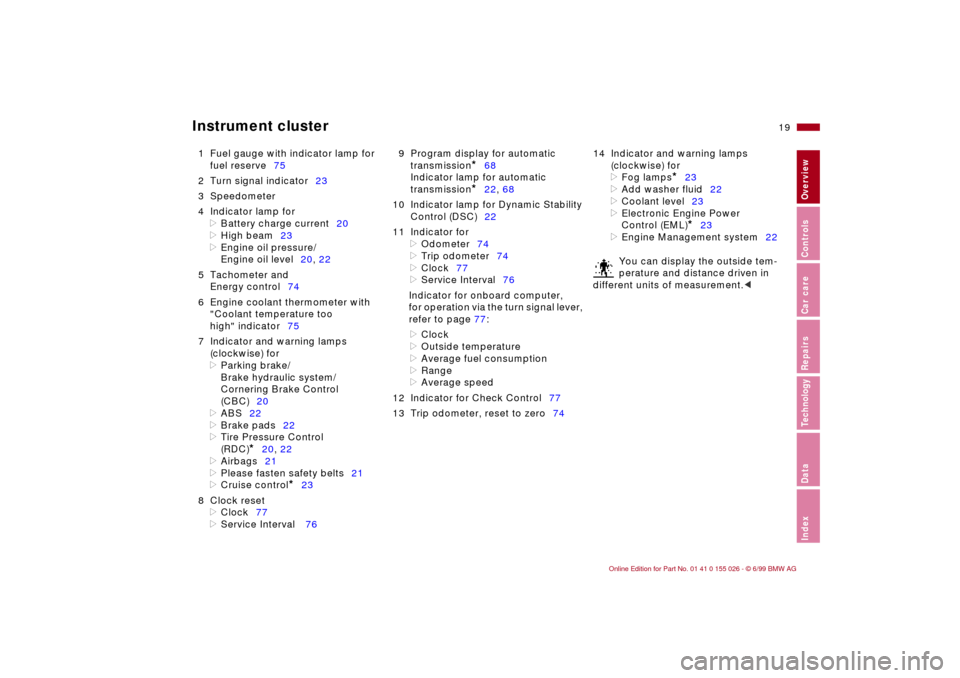
19n
RepairsIndexOverview Controls Car care Technology Data
Instrument cluster
1 Fuel gauge with indicator lamp for
fuel reserve75
2 Turn signal indicator23
3 Speedometer
4 Indicator lamp for
>
Battery charge current20
>
High beam23
>
Engine oil pressure/
Engine oil level20, 22
5 Tachometer and
Energy control74
6 Engine coolant thermometer with
"Coolant temperature too
high" indicator75
7 Indicator and warning lamps
(clockwise) for
>
Parking brake/
Brake hydraulic system/
Cornering Brake Control
(CBC)20
>
ABS22
>
Brake pads22
>
Tire Pressure Control
(RDC)
*
20, 22
>
Airbags21
>
Please fasten safety belts21
>
Cruise control
*
23
8 Clock reset
>
Clock77
>
Service Interval 769 Program display for automatic
transmission
*
68
Indicator lamp for automatic
transmission
*
22, 68
10 Indicator lamp for Dynamic Stability
Control (DSC)22
11 Indicator for
>
Odometer74
>
Trip odometer74
>
Clock77
>
Service Interval76
Indicator for onboard computer,
for operation via the turn signal lever,
refer to page 77:
>
Clock
>
Outside temperature
>
Average fuel consumption
>
Range
>
Average speed
12 Indicator for Check Control77
13 Trip odometer, reset to zero7414 Indicator and warning lamps
(clockwise) for
>
Fog lamps
*
23
>
Add washer fluid22
>
Coolant level23
>
Electronic Engine Power
Control (EML)
*
23
>
Engine Management system22
You can display the outside tem-
perature and distance driven in
different units of measurement.
<
Page 22 of 189
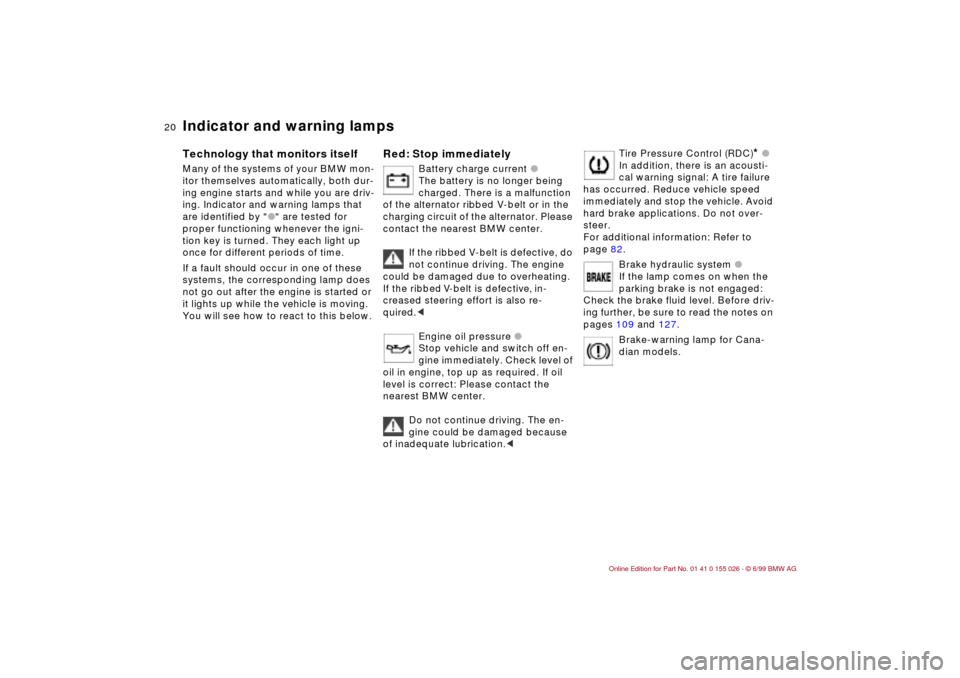
20n
Indicator and warning lamps
Technology that monitors itself
Many of the systems of your BMW mon-
itor themselves automatically, both dur-
ing engine starts and while you are driv-
ing. Indicator and warning lamps that
are identified by "
l
" are tested for
proper functioning whenever the igni-
tion key is turned. They each light up
once for different periods of time.
If a fault should occur in one of these
systems, the corresponding lamp does
not go out after the engine is started or
it lights up while the vehicle is moving.
You will see how to react to this below.
Red: Stop immediately
Battery charge current
l
The battery is no longer being
charged. There is a malfunction
of the alternator ribbed V-belt or in the
charging circuit of the alternator. Please
contact the nearest BMW center.
If the ribbed V-belt is defective, do
not continue driving. The engine
could be damaged due to overheating.
If the ribbed V-belt is defective, in-
creased steering effort is also re-
quired.
<
Engine oil pressure
l
Stop vehicle and switch off en-
gine immediately. Check level of
oil in engine, top up as required. If oil
level is correct: Please contact the
nearest BMW center.
Do not continue driving. The en-
gine could be damaged because
of inadequate lubrication.
<
Tire Pressure Control (RDC)
* l
In addition, there is an acousti-
cal warning signal: A tire failure
has occurred. Reduce vehicle speed
immediately and stop the vehicle. Avoid
hard brake applications. Do not over-
steer.
For additional information: Refer to
page 82.
Brake hydraulic system l
If the lamp comes on when the
parking brake is not engaged:
Check the brake fluid level. Before driv-
ing further, be sure to read the notes on
pages 109 and 127.
Brake-warning lamp for Cana-
dian models.
Page 23 of 189
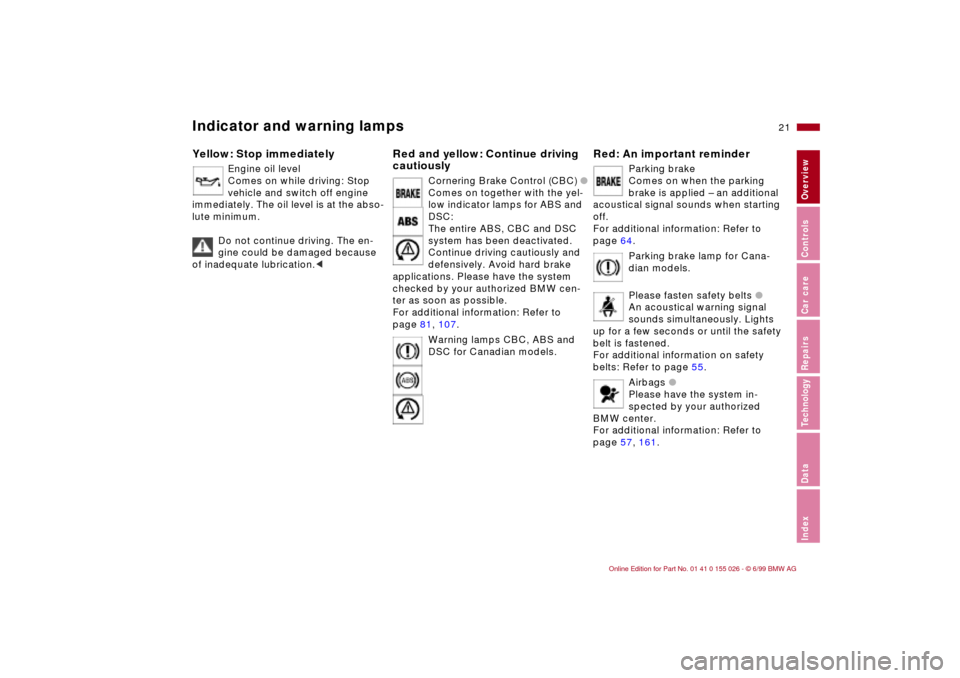
21n
RepairsIndexOverview Controls Car care Technology Data
Indicator and warning lampsYellow: Stop immediately
Engine oil level
Comes on while driving: Stop
vehicle and switch off engine
immediately. The oil level is at the abso-
lute minimum.
Do not continue driving. The en-
gine could be damaged because
of inadequate lubrication.<
Red and yellow: Continue driving
cautiously
Cornering Brake Control (CBC) l
Comes on together with the yel-
low indicator lamps for ABS and
DSC:
The entire ABS, CBC and DSC
system has been deactivated.
Continue driving cautiously and
defensively. Avoid hard brake
applications. Please have the system
checked by your authorized BMW cen-
ter as soon as possible.
For additional information: Refer to
page 81, 107.
Warning lamps CBC, ABS and
DSC for Canadian models.
Red: An important reminder
Parking brake
Comes on when the parking
brake is applied – an additional
acoustical signal sounds when starting
off.
For additional information: Refer to
page 64.
Parking brake lamp for Cana-
dian models.
Please fasten safety belts l
An acoustical warning signal
sounds simultaneously. Lights
up for a few seconds or until the safety
belt is fastened.
For additional information on safety
belts: Refer to page 55.
Airbags l
Please have the system in-
spected by your authorized
BMW center.
For additional information: Refer to
page 57, 161.
Page 32 of 189

30n
Locks and security systems:
Keys32
Electronic vehicle
immobilizer33
Central locking system34
Door locks – from outside34
Using the key34
Using the remote control35
Door locks – from inside38
Luggage compartment lid39
Luggage compartment41
Alarm system42
Electric power windows44
Sliding/tilt sunroof45
Adjustments:
Seats47
Seat and mirror memory50
Steering wheel51
Mirrors52
Car Memory, Key Memory54
Passenger safety systems:
Safety belts55
Child restraint systems56
Airbags57
Driving:
Steering/ignition lock62
Starting the engine62
Switching off the engine63
Parking brake64
Page 64 of 189
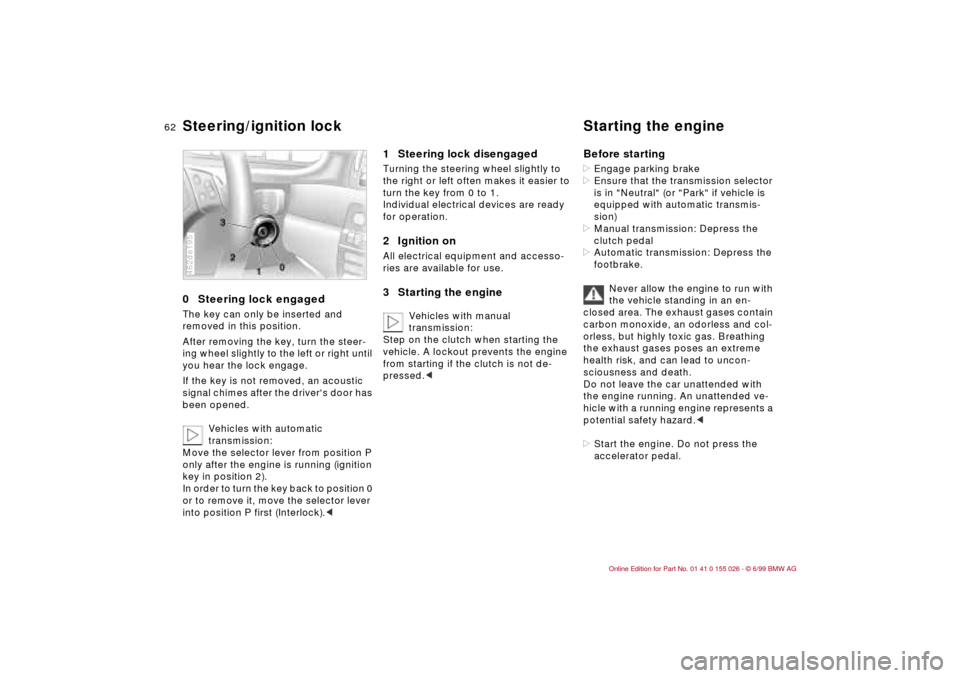
62n
0 Steering lock engaged The key can only be inserted and
removed in this position.
After removing the key, turn the steer-
ing wheel slightly to the left or right until
you hear the lock engage.
If the key is not removed, an acoustic
signal chimes after the driver's door has
been opened.
Vehicles with automatic
transmission:
Move the selector lever from position P
only after the engine is running (ignition
key in position 2).
In order to turn the key back to position 0
or to remove it, move the selector lever
into position P first (Interlock).<462de195
1 Steering lock disengaged Turning the steering wheel slightly to
the right or left often makes it easier to
turn the key from 0 to 1.
Individual electrical devices are ready
for operation.2 Ignition onAll electrical equipment and accesso-
ries are available for use.3 Starting the engine
Vehicles with manual
transmission:
Step on the clutch when starting the
vehicle. A lockout prevents the engine
from starting if the clutch is not de-
pressed.c
Before starting>Engage parking brake
>Ensure that the transmission selector
is in "Neutral" (or "Park" if vehicle is
equipped with automatic transmis-
sion)
>Manual transmission: Depress the
clutch pedal
>Automatic transmission: Depress the
footbrake.
Never allow the engine to run with
the vehicle standing in an en-
closed area. The exhaust gases contain
carbon monoxide, an odorless and col-
orless, but highly toxic gas. Breathing
the exhaust gases poses an extreme
health risk, and can lead to uncon-
sciousness and death.
Do not leave the car unattended with
the engine running. An unattended ve-
hicle with a running engine represents a
potential safety hazard.<
>Start the engine. Do not press the
accelerator pedal.
Steering/ignition lock Starting the engine
Page 65 of 189
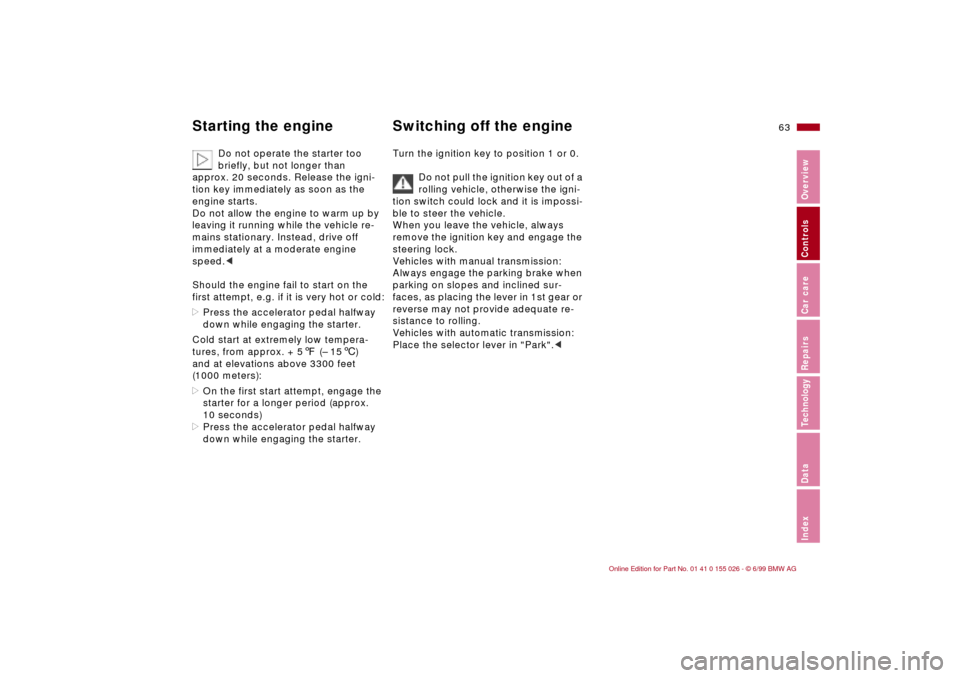
63n
RepairsIndexOverview Controls Car care Technology Data
Starting the engine Switching off the engine
Do not operate the starter too
briefly, but not longer than
approx. 20 seconds. Release the igni-
tion key immediately as soon as the
engine starts.
Do not allow the engine to warm up by
leaving it running while the vehicle re-
mains stationary. Instead, drive off
immediately at a moderate engine
speed.<
Should the engine fail to start on the
first attempt, e.g. if it is very hot or cold:
>Press the accelerator pedal halfway
down while engaging the starter.
Cold start at extremely low tempera-
tures, from approx. + 57 (– 156)
and at elevations above 3300 feet
(1000 meters):
>On the first start attempt, engage the
starter for a longer period (approx.
10 seconds)
>Press the accelerator pedal halfway
down while engaging the starter.
Turn the ignition key to position 1 or 0.
Do not pull the ignition key out of a
rolling vehicle, otherwise the igni-
tion switch could lock and it is impossi-
ble to steer the vehicle.
When you leave the vehicle, always
remove the ignition key and engage the
steering lock.
Vehicles with manual transmission:
Always engage the parking brake when
parking on slopes and inclined sur-
faces, as placing the lever in 1st gear or
reverse may not provide adequate re-
sistance to rolling.
Vehicles with automatic transmission:
Place the selector lever in "Park".<